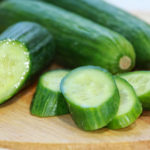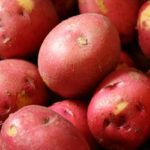Both sweet potatoes and potatoes originate from Central and South America. These tubers are also known as Solanum tuberosum, biologically belonging to the Solanaceae family, which includes tomatoes, peppers, and eggplants.
1 Sweet Potatoes
Sweet potatoes are agricultural crops with large, starchy roots that have a sweet taste and a distinctive flavor. They are commonly referred to as sweet potato roots.
Sweet potatoes play an important role in food supply as not only the roots but also the leaves and young stems are consumed as vegetables.
The outer part of the roots is usually purple, brown, or white, while the flesh can be white, yellow, orange, or purple. Sweet potatoes are widely consumed in Asian countries.
 Sweet potatoes are agricultural crops with large, starchy roots
Sweet potatoes are agricultural crops with large, starchy roots
2 Potatoes
Similar to sweet potatoes, potatoes are also short-duration crops grown for their starchy tubers.
Potatoes are a significant food source worldwide, especially in European and American countries. In 2008, the United Nations declared it the International Year of the Potato to honor its value in the global community.
However, only the tuber portion of potatoes is edible, as the sprouts can be harmful to health if consumed.
 Potatoes are short-duration crops grown for their starchy tubers
Potatoes are short-duration crops grown for their starchy tubers
3 Sweet Potatoes vs. Potatoes: Which Is Better?
Sweet Potatoes
Nutritional Value:
– Contain seven times more sugar than potatoes, resulting in a sweeter taste.
– Offer slightly higher amounts of vitamins and minerals compared to potatoes.
– Are particularly rich in Vitamin A, which has antioxidant properties.
Advantages:
– White-fleshed sweet potatoes have a low glycemic index, and their carotenoids help maintain stable blood sugar levels.
– The Vitamin C content in sweet potatoes boosts immunity and prevents colds and flu, while Vitamin A promotes healthy eyes and skin.
– They also play a role in breast cancer prevention.
Disadvantages:
– Due to their natural sweetness, sweet potatoes have limited versatility in cooking. They are typically used in sweet dishes.
– Consuming excessive amounts may cause digestive issues such as bloating.
Best Preparation Methods:
– According to recent studies, steaming or boiling sweet potatoes preserves their nutritional value the best.
– Steaming effectively breaks down harmful enzymes.
– Avoid consuming sweet potatoes with black spots, on an empty stomach, or if they have been stored for too long. It is also not advisable to use sweet potatoes as a rice substitute or eat them with the skin on.
 Avoid sweet potatoes with black spots or that have been stored for too long.
Avoid sweet potatoes with black spots or that have been stored for too long.
Potatoes
Nutritional Value:
– Potatoes provide higher amounts of calories, carbohydrates, protein, and starch.
– They contain lower levels of vitamins and minerals compared to sweet potatoes.
Advantages:
– The Vitamin C in potatoes strengthens the immune system.
– Potatoes are rich in vitamins and minerals, and their high calorie and starch content provide energy for the body.
– They also contain the antioxidants carotene and quercetin, which may help inhibit cancer cell growth.
Disadvantages:
– Potatoes have a high glycemic index, so people with diabetes should consume them in moderation.
– Excessive consumption may lead to digestive issues such as bloating.
Best Preparation Methods:
– Baking or roasting potatoes is the best way to retain their nutritional value without compromising your health.
– While boiling and steaming are healthy options, they may result in some loss of nutrients.
For further reference:
4 Choosing Between Sweet Potatoes and Potatoes
Whether it’s potatoes or sweet potatoes, deep-frying or stir-frying them is not recommended due to the high amount of oil involved.
Both sweet potatoes and potatoes offer numerous health benefits, so feel free to choose based on your preference or alternate between the two.
Although white-fleshed sweet potatoes are considered beneficial for diabetics, patients should still consult their doctors before including them in their diet.
 Deep-frying or stir-frying potatoes or sweet potatoes is not a healthy option.
Deep-frying or stir-frying potatoes or sweet potatoes is not a healthy option.
Additional Reference:
We hope that this information has provided you with a different perspective on these two types of tubers. Remember to choose the right preparation methods to ensure the well-being of yourself and your family.













